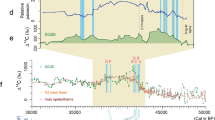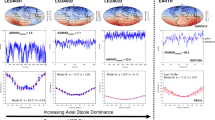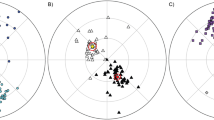Abstract
Recordings of palaeomagnetic excursions have revealed apparent field behaviour ranging from rather erratic directional movements and loopings1–4 to single, highly defined events5–7. Excursions of the latter variety show what seems to be a rapid change in direction such that the path of the associated virtual geomagnetic poles (VGPs) is well constrained in longitude. Such behaviour is not unlike that observed at the onset of some recorded polarity transitions7–9. Indeed, it has been suggested that excursions may occur during unsuccessful, or aborted, reversals2,5–7,10. We show here that available records of palaeomagnetic excursions, together with our present understanding of field behaviour associated with geomagnetic reversals, strongly support this hypothesis.
This is a preview of subscription content, access via your institution
Access options
Subscribe to this journal
Receive 51 print issues and online access
$199.00 per year
only $3.90 per issue
Buy this article
- Purchase on SpringerLink
- Instant access to full article PDF
Prices may be subject to local taxes which are calculated during checkout
Similar content being viewed by others
References
Denham, C. R. & Cox, A. Earth planet. Sci. Lett. 13, 181–190 (1971).
Barbetti, M. F. & McElhinny, M. W. Phil. Trans. R. Soc. A281, 515–542 (1976).
Verosub, K. L. & Banerjee, S. K. Rev. Geophys. Space Phys. 15, 145–155 (1977).
Liddicoat, J. C. & Coe, R. S. J. geophys. Res. 84, 261–271 (1979).
Doell, R. R. & Cox, A. in The Nature of the Solid Earth (ed. Robertson, E. C.) 245–284 (McGraw-Hill, New York, 1972).
Watkins, N. D. & Nougier, J. J. geophys. Res. 78, 6060–6068 (1973).
Hillhouse, J. & Cox, A. Earth planet. Sci. Lett. 29, 51–64 (1976).
Dodson, R. et al. Geophys. J. R. astr. Soc. 53, 373–412 (1978).
Fuller, M. et al. Rev. Geophys, Space Phys. 17, 179–203 (1979).
Cox, A. et al. Rev. Geophys. Space Phys. 13, 185–189 (1975).
Verosub, K. L. Science 190, 48–50 (1975).
Hoffman, K. A. & Fuller, M. Nature 273, 715–718 (1978).
Hoffman, K. A. Earth planet. Sci. Lett. 44, 7–17 (1979).
Hoffman, K. A. Phys. Earth planet. Int. 24, 229–235 (1981).
Hoffman, K. A. Science 196, 1329–1332 (1977).
Merrill, R. T. & McElhinny, M. W. Rev. Geophys. Space Phys. 15, 309–323 (1977).
Merrill, R. T. et al. Phys. Earth planet. Int. 20, 75–82 (1979).
Doell, R. R. & Dalrymple, G. B. Bull. geol. Soc 84, 1217–1242 (1973).
Wellman, P. et al. Geophys. J.R. astr. Soc. 18, 371–395 (1969).
Author information
Authors and Affiliations
Rights and permissions
About this article
Cite this article
Hoffman, K. Palaeomagnetic excursions, aborted reversals and transitional fields. Nature 294, 67–69 (1981). https://doi.org/10.1038/294067a0
Received:
Accepted:
Issue date:
DOI: https://doi.org/10.1038/294067a0
This article is cited by
-
Polarity Reversals from Paleomagnetic Observations and Numerical Dynamo Simulations
Space Science Reviews (2010)
-
Remanence acquisition and its alteration on sediments
Chinese Science Bulletin (1998)
-
Geomagnetic field intensity and reversals during the past four million years
Nature (1993)
-
Dipolar reversal states of the geomagnetic field and core–mantle dynamics
Nature (1992)
-
High-resolution sedimentary record of a geomagnetic reversal
Nature (1986)



